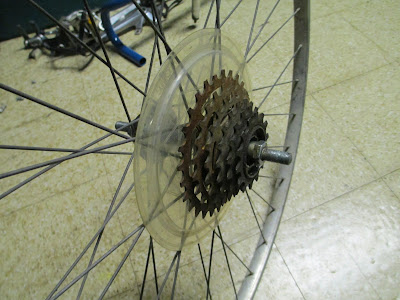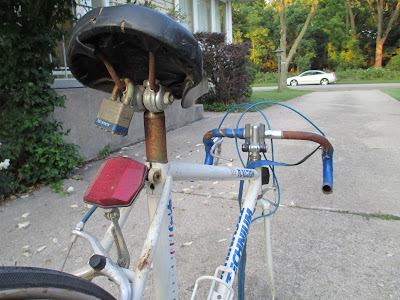This is going to be a long post. I finished tearing down an old Raleigh Technium 400, now I can restore it. With most of the parts off the frame, you can start servicing the bearings. On a bike like this one that has sat outside for years, this is pretty important. They'll be dirty, and riding the bike as-is will damage them (then you'll start to wonder why everything is wobbly and making clicking noises). I'll start with the bottom bracket. First loosen the lockring:
Then unscrew the left side cup (this one shouldn't be too difficult):
Now you can pull the spindle and bearings out:
I'm going a step further to remove the drive side cup. This way I can clean out the shell more easily. This one unscrews clockwise:
Eww:
Even after soaking in mineral spirits overnight, those drive side bearings are still rough and pitted. Those should be replaced (the shiny one on the right is ok though):
Here's the bottom bracket all back together:
Remember those rusty chainring bolts? I soaked them in Lime-Away overnight (cola works too):
Now it's time to deal with the dirty, faded paint. I used polishing compound all over the frame (except the decals):
The pulleys and springs in the rear derailleur were sticky, so I took it apart for service:
Two 8 mm bolts hold the pulleys in the cage:
A 6 mm Allen bolt holds the pulley cage knuckle together. Unscrew it and you can service the spring inside:
Cleaned, lubricated, and reassembled:
I did a previous tutorial on servicing that same derailleur here. Now it's time to reinstall the fork. First clean out the bearings and headset cups, then pack the bearings with water resistant grease. Next you can slide the fork back into the frame, and secure it with the top race:
Now comes the tricky part - You need to adjust the fork bearings with the top race so there's a slight bit of play in the fork. After you tighten the top nut this little bit of play usually disappears, and you'll get a perfect adjustment. This is a trial and error process, and it took me four tries to get this one just right:
I polished all the aluminum parts to make them look nice again. I also sanded of as much rust off the handlebars as I could, then spray painted the steel parts to prevent them from rusting again:
Time to do the wheel bearings. I start by loosening the locknut on one side while holding the bearing cone with a cone wrench:
Next I unscrew the cone and locknut, and pull the axle out:
Finally I'll clean all the bearings, then repack them with grease and reassemble the hub. You need to adjust the bearings so they spin nice and smooth, but don't have any play in the wheel.
With the rear wheel bearings repacked, I could reinstall the dork disk and freewheel:
Brakes reinstalled (a small ratchet with a 10mm socket makes this really easy):
Putting the right side crank back together:
Handlebars, shifters, and stem:
Saddle and seatpost:
Brake cables reattached to the levers and calipers (don't forget to oil the cables before sliding them into the housings):
Wheels back on so I can stand the bike up:
The last bike I worked on came with good tires. This time I wasn't so fortunate:
Cranks being reinstalled:
You don't need a torque wrench for crank bolts. In case you have one, however, I like to set mine just under 30 ft. lbs.
Rear derailleur reinstalled:
Got a new set of tires:
What's left to do is install the chain and adjust the brakes and shifters so they work well. That old chain actually works just fine after the motor oil soak. I had to retension the rear wheel since the spokes were pretty loose. All that I have to do now is put on some fresh blue handlebar tape and this project is done!
This wasn't as tough as it could have been, since almost all of the parts were in good shape and could be reused. If a rim was severely bent, or if the bike was missing important parts then this would have gotten a lot more difficult and expensive (and possibly not worth restoring). The only extra parts this thing needed were tires, brake pads, and handlebar tape. All in all, a pretty good deal :)
















































